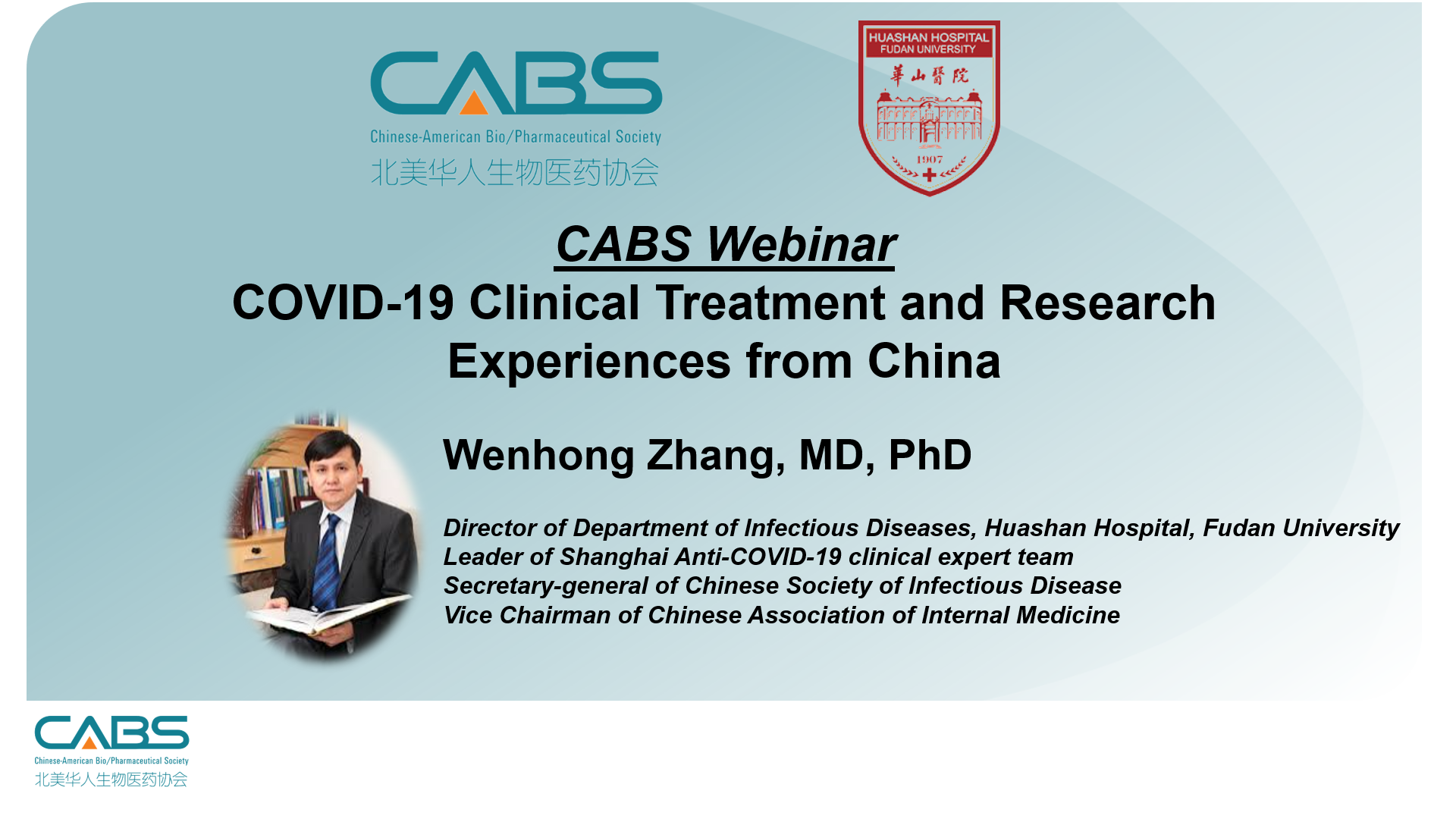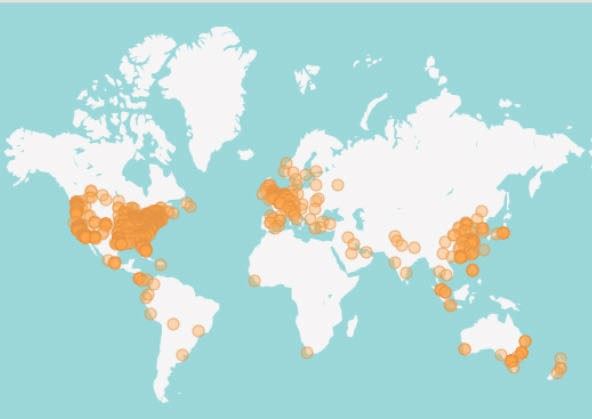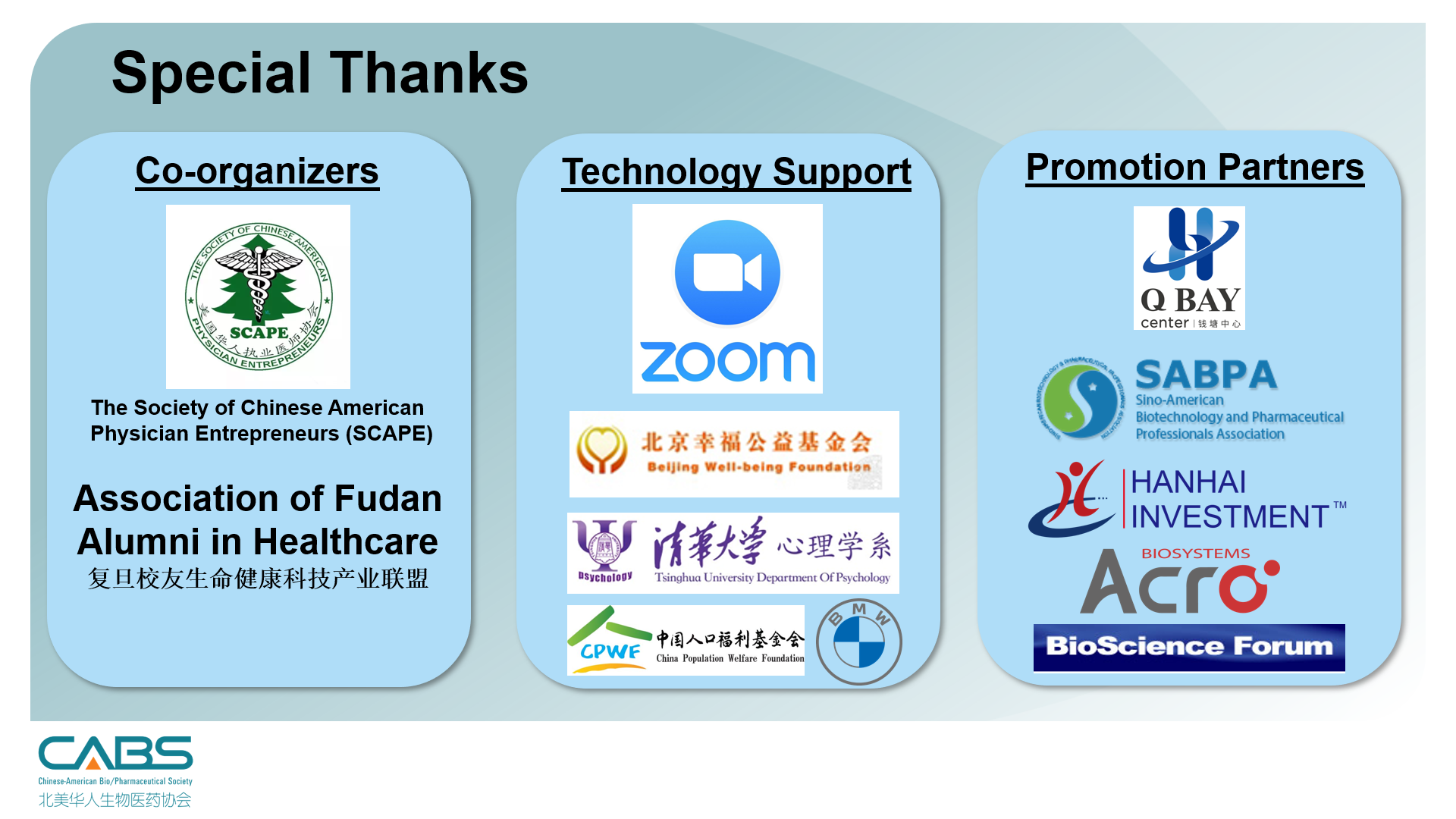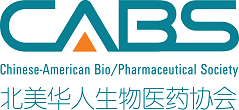Summary of CABS Webinar with Professor Wenhong Zhang (Q&A included)
Date: March 30, 2020 @ 1:00 pm – May 31, 2020 @ 11:30 pm
Location: Online
Disclaimer: the following summary of CABS webinar contains discussion on the potential use of certain drugs (such as hydroxychloroquine and others) for COVID-19. None of the drugs has been approved to treat COVID-19 at the moment of the webinar and the writing of this summary (US FDA issued EUA use of hydroxychloroquine). Please DO NOT use those drugs for COVID-19 without an official prescription from a licensed physician or doctor. CABS and Professor Wenhong Zhang will not hold liability for any consequence of using the drugs discussed in the webinar and this summary.
 On March 24, 2020, the Chinese American Biopharmaceutical Society (CABS) successfully hosted the webinar “COVID-19 clinical treatment and research experiences, with Dr. Wenhong Zhang”. The event was co-organized by the Society of Chinese American Physician Entrepreneurs (SCAPE) and the Association of Fudan Alumni in Healthcare. Dr. Zhang is the Director of Department of Infectious Diseases, Huashan Hospital, Fudan University, and the leading physician in the COVID-19 expert team in Shanghai. He presented valuable insights in controlling the COVID-19 outbreak and treating COVID-19 patients. The webinar attracted >10,000 healthcare and life sciences professionals from around the globe, including many frontline physicians and nurses who are fighting the disease in the U.S. and Europe (see the audience location map below).
On March 24, 2020, the Chinese American Biopharmaceutical Society (CABS) successfully hosted the webinar “COVID-19 clinical treatment and research experiences, with Dr. Wenhong Zhang”. The event was co-organized by the Society of Chinese American Physician Entrepreneurs (SCAPE) and the Association of Fudan Alumni in Healthcare. Dr. Zhang is the Director of Department of Infectious Diseases, Huashan Hospital, Fudan University, and the leading physician in the COVID-19 expert team in Shanghai. He presented valuable insights in controlling the COVID-19 outbreak and treating COVID-19 patients. The webinar attracted >10,000 healthcare and life sciences professionals from around the globe, including many frontline physicians and nurses who are fighting the disease in the U.S. and Europe (see the audience location map below).

Dr. Zhang first highlighted the success of COVID-19 infection control in Shanghai. One model had predicted Shanghai would see 800,000 COVID-19 cases, but as of now only around 400 have emerged. The key, as Dr. Zhang pointed out, was early control of local transmission. The first case in Shanghai, like in US, was identified on Jan 21, 2020. At that time, Wuhan’s lockdown suppressed most of the intercity traffic from Hubei provinces to Shanghai. Shanghai, at the meantime, immediately took aggressive measures to “slow down” the city, including cancelling all gathering activities, suggesting all citizens to stay at home unless necessary activities, and extending the Spring Festival holiday to 14 days, thus allowing Shanghai’s social distance to overlap the length of a 14-day incubation period if anyone really had a possible infection through encountering an imported case. At the same time, groceries, supermarkets, hospitals, banks and other life necessities facilities remained open for normal life. These extraordinary early efforts effectively prevented the spread of the virus.
In Shanghai, a network of 117 fever clinics and an additional 182 fever sentinel hospitals were positioned to collect all samples from suspicious cases meeting one epidemiology criterion and one relevant clinical symptom. All suspected patients met with the criterion could be tested freely and were admitted to the hospital quarantine ward to receive further evaluation by the CDC staff. Samples were then sent to CDC for diagnosis and confirmed COVID-19 patients were immediately transferred to designated hospitals.
In regard to the diagnosis, Dr. Zhang shared his knowledge on three aspects: co-infection, false negative rate of RT-PCR, and value of CT scan. First, co-infection was not uncommon: 11 out 20 patients contracted both COVID-19 and other pathogens. Secondly, false negative rate was relatively high (~30% of total samples), especially for the first-time PCR test. The false negative rate dropped another 50% (to 15% of total samples) for the second-time PCR test. The reason for RT-PCR false negativity might be due to the quality of the kit, the laboratory technique, the sampling technique and the sampling site. If a patient still tested negative after two PCRs but showed clinical symptoms, next generation sequencing (NGS) would follow and could confirm all diagnoses. Lastly, although chest CT scan could be used to detect COVID-19, the CT scan could share the similar resemblance in non-COVID-19 pneumonia patients. Therefore, COVID-19 diagnosis by CT scan alone was not adequate; PCR tests represented the first line diagnosis for patients.
To summarize, suspected cases were enrolled and diagnosed at Huashan Hospital using the following protocol (Figure 5 of this publication https://www.medrxiv.org/content/10.1101/2020.02.13.20022673v1.full.pdf). To rule out false negative cases, suspected cases had to pass two COVID-19 PCR tests. If cases tested negative twice in a roll but were highly suspicious by clinical symptoms or if the patients were in severe conditions, a third test would be performed either by repeating the PCR test, or performing mNGS, or arranging the test by a third party.
Timely and extensive testing of the suspected population is crucial in the prevention and control of the COVID-19. The timely diagnosis protocol and timely quarantine measure in Shanghai effectively stopped the circulation of COVID-19 in the city, without causing overwhelming impact on the normal citizen’s life. Dr. Zhang’s team also found that the incubation time, as measured as days from suspected contact to symptom onsets is about 6.4 days (mean); and the mean onset-hospital admission interval was 5.5 days.
In regard to treatment options for COVID-19, Dr. Zhang indicated that no effective antiviral treatment had been identified to this date. Several drugs, including arbitol, lopinavir/ritonavir, hydroxychloroquine sulfate, and remdesivir are currently invested in clinical trial. Shanghai was the first city to use hydroxychloroquine in the treatment, but evidence for its clinical efficacy was not significant; nevertheless, toxicity of hydroxychloroquine seems low and doctors can consider it as treatment option. Sufficient respiratory support, especially oxygen therapy, made a key difference in the survival of patients. A paper published by Dr. Yuanlin Song reported the invasive mechanical ventilation support rate and mortality rate in Wuhan, and when we compared that data with that of Shanghai, the result would suggest that a higher ventilation support rate led to a significantly lower mortality.
Recent studies showed that organ and coagulation dysfunction (e.g. higher lactate dehydrogenase and D-dimer) were crucial factors for the progression from acute respiratory distress syndrome (ARDS) to death, so anticoagulation at the early stage could help reduce microthrombus. Although no strong clinical evidence of anticoagulant or corticosteroids had been observed, Dr. Zhang found that the use of corticosteroids could sometimes slow the progression of disease and reduce the severity in patients with ARDS. Regardless, timely life support for critically ill patients, such as cannula or mask oxygen inhalation, high-flow nasal cannula oxygen therapy, invasive mechanical ventilation and extracorporeal membrane oxygenation (ECMO), is important. Organ support, hemodynamic stability, nutritional support, analgesia and sedation should also be maintained. The overall mortality rate of COVID-19 is around 3-4% (<1% in Shanghai), but there is only a short time window for intervention during the treatment.
Finally, protecting medical personnel is crucial. None of the 400 medical personnel from Shanghai who went to support Wuhan was infected. To achieve this, a standardized process needs to be established to allow access to appropriate personal protective equipment (PPE). These include medical protective masks, isolation gowns, goggles or visors, double-layer gloves, double-layer shoe covers, etc. Positive pressure breathing masks are recommended for medical personnel. Disinfection and isolation are also important for protection. Using hydrogen peroxide to disinfect the environment at least once every 4 hours and at the end of procedures is recommended.
At the end of the webinar, Dr. Zhang and his team answered dozens of questions, pre-submitted by the audience, related to COVID-19 diagnosis, disease progression, clinical treatment, discharge and follow-up, as well as protection for medical personnel (see below for details of the Q&A during the webinar. CABS will follow up another email or posting on Dr. Wenhong Zhang’s answer to questions from the audiences after the webinar). A publication from Dr. Wenhong Zhang lab is here and contains data for the webinar (https://www.medrxiv.org/content/10.1101/2020.02.13.20022673v1.full.pdf).
We thank Dr. Jingwen Ai for answering some of these questions and Mr. Yifan Wang for assisting with the logistics. We really appreciate the valuable insights from Dr. Zhang and his team, and we will work in solidarity to fight this global pandemic.
Q1: What is the time window between infection and testing positive?
A: PCR test will usually turn positive under 2-3 days after the infection. Serological test i.e. antibody- based test (IgM) would mostly turn positive in 8-10 days after the disease onset. Viral load is the highest during the first week of disease onset and would decrease later.
Q2: For the general public, what are the criteria to request a SARS-CoV-2 test? For healthcare workers?
A: In Shanghai, people who meet at least one of the epidemiological criteria and one of the clinical criteria should request a test. Originally, only people who returned from Wuhan and Hubei province would meet the epidemiological criteria. Now people with travel history to any countries/regions with local transmission cases meet the epidemiological criteria. People should also request a test if they have close contact with confirmed patients or if clustered cases were observed around them. Clinical criteria include symptoms such as coughing, fever and diarrhea. We try to test every suspected case in Shanghai and this is the key to closely monitoring the epidemic trend. All tests are provided free of charge.
Q3: What are the pros and cons of PCR-based test Vs antibody-based test?
A: PCR test is the gold standard. We are still gaining more experiences concerning antibody-based tests in Shanghai. Currently, antibody-based test can serve as a complementary test to the PCR test. It might work better after 8-10 days of disease onset because the viral load might be too low to be detected by PCR test (false negative) in the later stage. Antibody tests could also be a useful tool to understand the epidemic trend for a large population.
Q4: How to prevent viral RNA degradation during sample processing?
A: The sample should be processed as soon as possible (usually within 4-6 hours), and if not, sample should be stored at -20C/-80C.
Q5: For people who are self-quarantined for 14 days at home, should they be tested? If yes, when and how frequent?
A: If no symptom was observed after quarantine, no test is needed.
Q6: What is the risk of getting infected for pregnant women and infants compared to other demographic groups? If infected, what are the treatment options?
A: Not many cases of pregnant women and infants were reported in Shanghai. Only 50-60 children were treated and they all have mild symptoms. No anti-viral treatment was used on children in Shanghai. No severe cases for pregnant women, infant and children observed in Shanghai.
Q7: From mild to severe symptoms, how long will it take?
A: Usually 8-9 days.
Q8: Why people with underlying medical conditions are at high risk? Young age but with underlying conditions are also at high risk?
A: Young people with underlying medical conditions are also at high risk. People with heart disease have the highest risk.
Q9: At large population level, do you observe the attenuation of the infectivity or pathogenicity of SARS-CoV-2 over time?
A: Not observed so far. The number of severe cases has decreased but there’s probably no attenuation of the infectivity of the virus.
Q10: Ibuprofen VS acetaminophen, which one is better to treat fever at home for mild COVID-19 patient?
A: Acetaminophen is recommended because of fewer side effects.
Q11: Literature reported that ARB inhibitor like Losartan can increase cell surface ACE2 expression. Do you observe people who are taking ARBi showing a higher chance of SARS-CoV-2 infection? How about use Losartan to reduce lung inflammation in COVID-19?
A: We did not observe people who are taking ARBi showing a higher chance of SARS-CoV-2 infection. ARBi losartan has not shown effect in reducing lung inflammation in SARS-Cov-2 cases.
Q12: What is the percentage of recovered patients showing detectable neutralizing antibodies against SARS-CoV-2? What type of antibodies? What is the efficacy against COVID-19?
A: Antibodies were detected in all recovered patients. It’s still hard to say if they have efficacy or not. It also depends on the type of antibody produced.
Q13: Will upcoming summer slowdown global pandemic of COVID-19?
A: Summer might help a little bit, as the activity of the virus has shown to decrease with the temperature rising. However, this phenomenon was mostly observed in the laboratory, and the temperature would need to be as high as around 60℃ to kill the virus. Therefore, the summer might slow down the transmission in the northern hemisphere to some extent, but we still need to remember the risks of epidemics in the southern hemisphere will not diminish by that time. COVID-19 might not be eliminated this year. It might reappear in the winter. The coming 2-3 months is critical for US to take actions to slowdown the spread of the disease.
Q14: Can hydroxychloroquine help to prevent COVID-19? Dose and side effects?
A: Data currently available is controversial. However, it’s probably OK for medical personnel and family members to take hydroxychloroquine under strong cautions to prevent COVID-19, as long as no significant side effect is observed.
Q16: How to use hydroxychloroquine for COVID-19 treatment? Dose and frequency?
A: The dosage we used was day 1: 400mg b.i.d., day 2 and after: 400mg q.d. Only monotherapy has been used. We are worried about liver injury caused by the combination therapy with azithromycin, and that’s why we have not tried the combination of hydroxychloroquine and azithromycin. We have not tried the hydroxychloroquine and zinc combination either.
Q18: How important it is to cover head/neck/shoes when treating COVID patients?
A: Covering the head is the most important.
Q19: How often are HCWs infected from the virus?
A: Only HCW in Wuhan without proper PPE at the beginning of the outbreak were infected. None of the HCW in Shanghai or HCW sent to Wuhan from Shanghai with proper PPE was infected.
Q20: Is regular surgical mask adequate for HCWs to prevent COVID-19 under mild patient and severe patient?
A: No. N95 is required. PPE is very important.
Q21: Are you routinely testing healthcare workers who are exposed to COVID+ patients?
A: In Huashan hospital we test HCWs. However, it’s probably not necessary to do the test if people wear proper PPE and no symptom is observed.
Q22: Can COVID-19 be transmitted by air droplet/airborne, in closed spaces, such as elevator, waiting room?
A: Air droplet would impose a risk to people without proper PPE (masks). However, in our hospital no patient was infected via air droplet in the elevator or fever clinics. Only close contact with an infected person would transmit the disease.
Q23: At US, healthcare workers go home after work. What procedure need to be done to prevent spreading the virus to family members?
A: Healthcare workers at Shanghai Public Health Clinical Center would stay at the hospital. Those who work at the Shanghai Children’s Hospital do go home every day. They wear proper PPE, take bath and wash face and nose frequently. In addition, they do not have dinner together with their family members.
Q24: For hospital departments that do not directly interact with COVID-19 patients, can healthcare workers use reduced PPE?
A: No.
Q25: For healthcare workers that interact with COVID-19 patients, what need to be done before eating and drinking?
A: Proper PPE is required, and frequent cleaning of face and nose is recommended.
Q26: What is the procedure to discharge COVID-19 recovered patients? Do they need to self-quarantine at home for 14-days?Is there a possibility of viral rebound?
A: The patient can be discharged if tested negative by PCR test twice. After discharge, we require the patient to be quarantined at home for 14 days.
Q27: If a patient survived severe COVID-19, will his/her lung surfer long term injury? Fibrosis?
A: Unlike SARS patients, most severe COVID-19 patients fully recovered in less than two weeks. They are all in good conditions with no or minimal fibrosis.
To learn more about CABS’ effort in COVID-19 response, please visit our website www.cabsweb.org.
Please contact: info@cabsweb.org for any question related to COVID-19.

.
